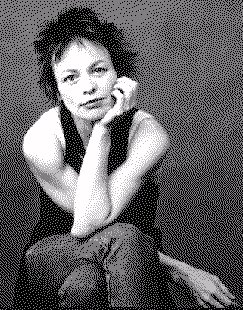
Music Library | Linkage | Literature Home Page |Image Gallery | Home |

Music Library |
Linkage |
Literature Home Page |Image Gallery |
Home |

I used to think the future was art because the avant garde was supposedly the future and I liked the idea of living in a place where things hadn't happend yet. But at the moment I'm having a lot of trouble finding the avant garde. Maybe it's somewhere and I'm completley wrong about this, but I don't think so. And I think the disapearance of the avant garde has something to do with speed. I mean, the lag time between uptown and downtown New York is now a matter of a couple of days. For example, let's say there is a young artist, and lets say he's a he and he might have some fantasies about what the life of an artist is: big loft, green plants, parties, a little work, some minimal suffering followed by his picture in a Gap ad and eventually media startdom. Then he realizes he can't afford the loft right now, times are a little hard, so he takes a job in an ad agency but every saturday he goes to the galleries to see what's up and by Monday morning these downtown images are comped up in an ad for cars or shoes or cigarettes. I mean, it's that fast. The existance of the avant garde depends on it's ability to hide, and in New York anyway there's nowhere left to hide.
But back to the question who is art for? Every time I wonder about it, I hear the voice of Walter Annenberg sniffing, "I'm sick of people expressing their artistic attitudes in an unappetizing manner." Every body knows that are is a question of taste but the way he puts it something or someone is definitely eating and something or someone is definitley getting eaten. Taste becomes consumption.
O.K., now for my theory of the recent history of words in art. You see, back in the fifties there were all these abstract expressionist artists and even though they were hanging out at the Cedar Bar every night talking and drinking, they weren't really articulate. I mean it was a macho thing: uh, Paint...the BIG GESTURE, the, uh, paint like qualities of paint, dripping, how PAINT could look so much like, well, so much like paint.
Of course this left a lot of room for the poets. And remember poetry in the fifties was considered pretty suspicious, a kind of code invented by the intelligentsia so that regular people couldn't figure out what they were talking about, and it was these guys, the poets, who were moonlighting as art critics. And the reviews were basically poems that had some very oblique relationship to the paintings, but they were actually pretty good ways for the poets to get idea's for their next poems.
Then along came a generation of very articulate artist, guys like Barnett Newman, who, even though he said, "Esthetics is to me what ornithology is to the birds" didn't seem to really believe this, because he wrote very long and also very beautiful essays on his own work. I mean, why wait for the critics to write about what it means when you can do it yourself?
And these came out as huge, slick, wordy catalogues, and you really needed them too. I mean sometimes it's nice to stand in front of a solid blue surface with a brown stripe running down the side and make up your own fantasies about it, but sometimes it's more interesting to find out what led this particular artist to paint this particular stripe. It was as if the artist were standing in front of the painting and talking talking talking about it.
I always thought of my own work as part of this process, that eventually the object itself would disappear or it would become very ordinary and there would just be endless streams of words.
Email SoundGasm
Page Updated June 7, 1999
© SoundGasm